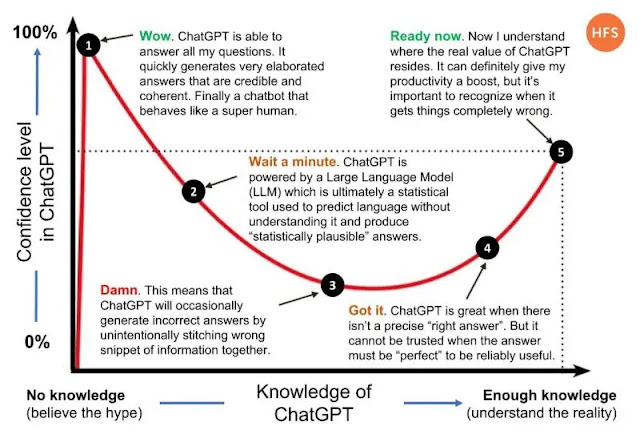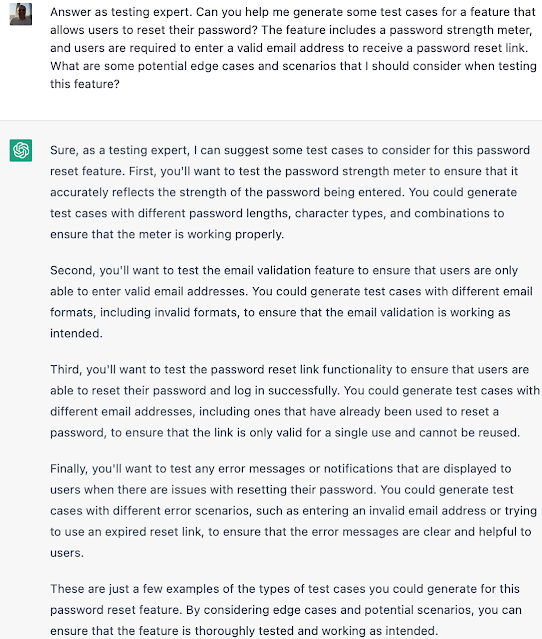Learning Tips for Using ChatGPT in Software Testing

ChatGPT is a powerful tool that can be useful for a wide range of applications, from creative writing and conversation to research and decision-making. For software engineers in test, ChatGPT can be an invaluable resource for generating test cases, automating repetitive tasks, and even assisting with bug triaging. However, in order to use ChatGPT effectively, it’s important to understand its limitations and biases, experiment with different prompts, and provide rich context. In this article, we’ll explore some best practices and tips for using ChatGPT in a software testing context, so that you can get the most out of this powerful tool.
Beware of the Dunning-Kruger Effect

One of the most important things to keep in mind when using ChatGPT is the Dunning-Kruger Effect. This psychological phenomenon refers to the tendency for people to overestimate their abilities in a given area, especially when they have limited experience or knowledge. When using ChatGPT, it’s important to be aware of this effect and not get too excited or too discouraged too soon. Remember that ChatGPT is just a tool, and like any tool, it has its limitations. It’s important to approach ChatGPT with a healthy dose of skepticism and use it as a supplement to your own knowledge and expertise. By doing so, you’ll be able to get the most out of this powerful tool and avoid the pitfalls of the Dunning-Kruger Effect.
Try to find its limitations first
When using ChatGPT, it’s important to understand its limitations and occasional falsehoods. One way to do this is to ask it about something you’re an expert in, such as Scrabble, gardening, or chess. By doing so, you’ll quickly discover its limitations and biases, and be able to build proper expectations about its capabilities. For example, if you’re an expert Scrabble player, you might ask ChatGPT to generate a list of high-scoring words for a given board. If ChatGPT generates words that are clearly incorrect or not allowed in the game, you’ll know that it has limitations in this area. By finding ChatGPT’s limitations and occasional falsehoods, you’ll be better equipped to use it effectively and avoid relying on it too heavily.
Be mindful of data privacy
When using ChatGPT, it’s important to be mindful of data privacy. ChatGPT uses data to generate its responses, which means that any personal or sensitive information you provide could be stored and potentially shared with others. To protect your privacy, avoid providing personal or sensitive information when using ChatGPT. Additionally, be aware that ChatGPT may store your conversations and use them to improve its algorithms. If you’re uncomfortable with this, consider using a secure communication channel or opting out of data sharing. By being mindful of data privacy, you can use ChatGPT safely and effectively while protecting your personal information.
Be aware of biases
It’s important to be aware of biases when using ChatGPT. Like any machine learning model, ChatGPT is trained on a large dataset, which means that it can be influenced by biases present in the data. For example, if the dataset used to train ChatGPT is skewed towards a particular demographic or viewpoint, ChatGPT may exhibit bias in its responses. To mitigate these biases, it’s important to provide a diverse range of data sources when training ChatGPT. Additionally, when using ChatGPT, be aware of any biases that may be present in its responses. If you notice bias, consider adjusting your prompts or seeking input from a diverse group of people. By being aware of biases and taking steps to mitigate them, you can use ChatGPT effectively and responsibly.
Try to do something specific using it as assistance

When using ChatGPT, it’s important to have a specific task or goal in mind. Rather than randomly querying it, try to use ChatGPT as assistance for a particular task, such as generating ideas for a writing project or automating certain tasks in software testing. By having a clear goal in mind, you can prompt ChatGPT more effectively and verify the quality of its responses. This is especially important because ChatGPT may generate responses that are incorrect, incomplete, or biased. By using ChatGPT as assistance for specific tasks and verifying its responses, you can ensure that you’re getting the most out of this powerful tool.
You can for example write a blogpost ;)
Treat ChatGPT as a supervised employee. Do not delegate tasks. Micromanage.
When using ChatGPT, it’s important to treat it as a supervised employee rather than delegating tasks to it. This means that you should approach ChatGPT as a tool to assist with specific tasks, rather than relying on it to make decisions or take actions on its own. In addition, it’s important to avoid micromanaging ChatGPT or expecting it to perform tasks beyond its capabilities. Instead, provide clear instructions and supervision, and verify the quality of its responses. By treating ChatGPT as a supervised employee, you can ensure that you’re using it effectively and responsibly, and avoid relying too heavily on its capabilities.
Start with the expected outcome in mind
When using ChatGPT, it’s important to start with the expected outcome in mind. This means that you should have a clear idea of what you want ChatGPT to generate, whether it’s a piece of writing, a set of test cases, or something else entirely. By starting with the expected outcome in mind, you can prompt ChatGPT more effectively and get the results you’re looking for. However, it’s important to keep in mind that prompt engineering is a skill that takes time to master. You may need to experiment with different prompts, adjust your expectations, and provide more context in order to get the results you want. By practicing prompt engineering and starting with the expected outcome in mind, you can use ChatGPT more effectively and get the most out of this powerful tool.
Provide rich context. Be descriptive
When using ChatGPT, providing rich context is essential for getting accurate and helpful responses. This means being descriptive and specific in your prompts, and providing as much information as possible about the task or problem you’re trying to solve. For example, if you’re asking ChatGPT to generate test cases for a software application, it’s important to provide information about the application’s features, user personas, and potential use cases. The more information you can provide, the more accurate and relevant ChatGPT’s responses will be. Similarly, if you’re using ChatGPT for creative writing or brainstorming, providing rich context can help you generate more nuanced and interesting responses. This might include information about the characters, setting, tone, and genre of the writing project. By providing rich context, you can ensure that ChatGPT has a better understanding of what you’re looking for, and generate responses that are more accurate, helpful, and tailored to your needs.
Try to understand the basic technicalities behind it
To use ChatGPT effectively, it’s helpful to understand some of the basic technicalities behind it. For example, ChatGPT is a generative language model, which means that it’s designed to generate text based on a given prompt or context. The way it generates text is by predicting the probability of each word in the sentence based on the words that came before it, using a technique called language modeling. Generative language models like ChatGPT are trained on large datasets of text, such as books, articles, and websites, which allows them to learn patterns and relationships in language. This means that when you give ChatGPT a prompt, it uses this knowledge to generate a response that is likely to be coherent and grammatically correct. However, it’s important to keep in mind that ChatGPT’s responses are not always perfect, and it may generate responses that are incomplete, biased, or outright incorrect. By understanding the basic technicalities behind ChatGPT, you can better understand its strengths and limitations, and use it more effectively in your work.
Recommended books:
Meta:
Algorithms visualisation:
Various:
- AI and Machine Learning for Coders
- Artificial Intelligence: a Novel Approach
- Generative Deep Learning
- Deep Learning with Tensorflow and Keras
- Transformers for Natural Language Processing
For help with decision-making, create alter egos and assess the quality of the responses.
Creating alter egos can be a helpful technique when using ChatGPT for decision-making. By creating different personas with different backgrounds and expertise, you can prompt ChatGPT to generate responses that take into account a variety of perspectives. For example, you might create an alter ego for a testing expert and prompt ChatGPT to generate test cases for a complex software application. This alter ego might have extensive knowledge of testing best practices and be able to provide insights and suggestions that you wouldn’t be able to generate on your own. By assessing the quality of the responses from your testing expert alter ego, you can determine whether ChatGPT’s responses are accurate, relevant, and helpful. If the responses are not satisfactory, you can adjust your prompts or seek input from other alter egos to get a more well-rounded perspective. By using alter egos to assist with decision-making, you can leverage the power of ChatGPT to generate insights and ideas that you might not be able to generate on your own.

Stay up to date with the latest generative AI developments
Staying up to date with the latest generative AI developments can help you stay informed about new techniques, models, and use cases in this exciting field. One way to stay up to date is to follow online communities and forums focused on generative AI and machine learning. These communities can provide a wealth of information and insights about the latest research and developments in the field. Additionally, attending conferences and workshops focused on generative AI can provide opportunities to learn from experts in the field and see the latest advancements in action. Finally, reading research papers and publications from top AI researchers can provide a deep understanding of the latest techniques and models in generative AI. By staying up to date with the latest developments in generative AI, you can ensure that you’re using the latest techniques and models in your work, and stay ahead of the curve in this exciting and rapidly evolving field.
For the testing-specific tips I recommend to take a look into my post:
Revolutionizing Test Engineering with ChatGPT: Exploring the Possibilities of AI in Testing
Tags: AI, artificial intelligence, ChatGPT, test automation
Categories: Generative AI
Updated:
